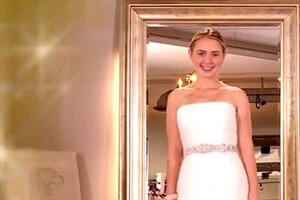GOP 'wedding dress' ads: Can you wear white at a second election?
The College Republican National Committee has released a controversial series of ads that depicts a bride-to-be shopping for her gubernatorial choice.

Washington
Voting for governor – it’s just like picking a wedding dress isn’t it? You flip through option after option but their sleeves are too long or tax programs too expensive. Then you find The One – it’s perfect, it will set off your hair color just right and fill you with fiscal confidence on that long walk down the aisle.
To the voting booth, not the altar.
Or not. Maybe you’ve never connected satin and tulle with elections. But the College Republican National Committee has, and they’ve released a controversial series of ads aimed at young voters that depicts a bride-to-be shopping for a real-life gubernatorial choice as if it were a wedding dress.
These “Say Yes to the Candidate” ads are reminiscent of TLC’s “Say Yes to the Dress” reality show. They start with a young woman named “Brittany” twirling amidst sparkles and bubbles while wearing her simple, modern choice of wedding gown.
Brittany mentions that budget is important to her now that she’s just graduated from college. “The Rick Scott is perfect!” she exclaims.
“Rick Scott is becoming a trusted brand,” she adds in a voice-over.
But mom has other ideas. “I like the Charlie Crist,” she says in her best momzilla impersonation. “It’s expensive and a little outdated, but I know best.”
Eye-rolling and friend commentary ensues. The “Charlie Crist” is depicted as ensnaring Brittany in debt for the rest of her life.
Then comes the dramatic climax.
“Mom, this is my decision,” declares Brittany. “And I see a better future with Rick Scott!”
This is the Florida version of the wedding dress spot. Incumbent GOP Gov. Rick Scott is running for reelection in a tight race against former governor Charlie Crist.
If you check out the CRNC YouTube channel, you can find almost-identical versions for a number of other states with gubernatorial contests. There’s the Pennsylvania model (“The Tom Corbett is perfect!”), the Michigan model (“The Rick Snyder is perfect!”), the Illinois version (“The Bruce Rauner is perfect!”), a Colorado version (“The Bob Beauprez is perfect!”) and copy for Arkansas (“The Asa Hutchinson is perfect!”)
Democrats say they’re aghast. Their point of view is that the ads are sexist and inexplicable – does the GOP really think condescending to millennial women is the best way to attract younger voters?
By the way, they add, most women don’t get married right out of college any more.
“Sometimes, it’s hard not to wonder whether Republicans are trying to drive women voters away on purpose,” writes Steven Benen on MSNBC’s left-leaning Rachel Maddow blog.
It’s possible these ads will work, though. They break through the clutter. Maybe the arch reference to a reality show will make them seem within cultural bounds? We gave up predicting ad effectiveness long ago – there are too many variables.
But here’s their underlying secret: not that many actual voters may see them. The CRNC has about $2 million for its entire field budget this cycle. According to news reports, the group will spend about $1 million on the dress ads. Spread over six states, that is unlikely to move anybody’s poll numbers.
Sometimes, political ads created by non-candidate groups are intended to drive news coverage, and raise the profile of the group itself. Remember “Creepy Uncle Sam?”
Also, identical ads churned out for multiple races often don’t work. That’s a good point made by political scientist Jonathan Bernstein at Bloomberg View.
It’s easy for the targets of the ads to frame their own ads about how outside interests who don’t actually care about the state in question are backing their foe. They just have to run clips of all the ads together, to show their assembly line quality.
Most campaign professionals learned that long ago, according to Mr. Bernstein.
“It’s a classic example of the way elections are conducted in the US: Candidates’ campaign organizations are seemingly in charge, but decentralized party and quasi-party organizations step in and help –or embarrass – them,” he writes.


